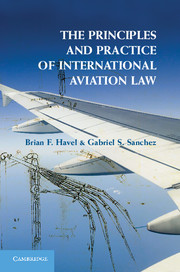Book contents
- Frontmatter
- Contents
- Preface
- Acknowledgments
- Table of Abbreviations and Acronyms
- 1 What is International Aviation Law?
- 2 The Foundations of Public International Aviation Law
- 3 The International Law Regime for Trade in Air Services
- 4 The International Law Regime for Airline Investment and Global Alliances
- 5 The International Law Regime for Aviation Safety and Security
- 6 The International Law Regime for Aviation and the Environment
- 7 The International Law Regime for Air Carrier Liability and Surface Damage
- 8 The International Law Regime for Aircraft Financing and Aircraft Nationality
- Afterword
- Select Bibliography
- Table of Authorities
- Index
- References
7 - The International Law Regime for Air Carrier Liability and Surface Damage
Published online by Cambridge University Press: 05 June 2014
- Frontmatter
- Contents
- Preface
- Acknowledgments
- Table of Abbreviations and Acronyms
- 1 What is International Aviation Law?
- 2 The Foundations of Public International Aviation Law
- 3 The International Law Regime for Trade in Air Services
- 4 The International Law Regime for Airline Investment and Global Alliances
- 5 The International Law Regime for Aviation Safety and Security
- 6 The International Law Regime for Aviation and the Environment
- 7 The International Law Regime for Air Carrier Liability and Surface Damage
- 8 The International Law Regime for Aircraft Financing and Aircraft Nationality
- Afterword
- Select Bibliography
- Table of Authorities
- Index
- References
Summary
A Hybridized Structure
In the first four chapters we discussed the principal components of the public dimension of international aviation law, namely, the Chicago Convention and the bilateral system of cross-border trade in air services. In the previous two chapters we considered other significant issues of public law, including safety and security and evolving regimes to control aircraft carbon emissions and noise pollution. This chapter turns primarily to the private transnational legal rules governing air carrier liability for injury or damages to passengers and cargo on international flights as well as to the fairly rudimentary provisions that international law provides to compensate passengers and shippers for delay. The system of international air carrier liability is an unusual hybrid of public international law and private transnational law: the primary rules are set forth in international treaties (public international law) and in some agreements that are not, strictly speaking, treaties. But all disputes that arise under these various public international law instruments concerning the scope of the rules and liability for damages are adjudicated in the domestic court systems of the contracting States rather than by international judicial bodies. As we will see in the next and final chapter of the book, in modern international aviation law, only the Cape Town Convention (as it relates to ownership interests in aircraft) has a comparable hybridized structure that straddles both the public and private dimensions of international law.
- Type
- Chapter
- Information
- The Principles and Practice of International Aviation Law , pp. 251 - 324Publisher: Cambridge University PressPrint publication year: 2014



